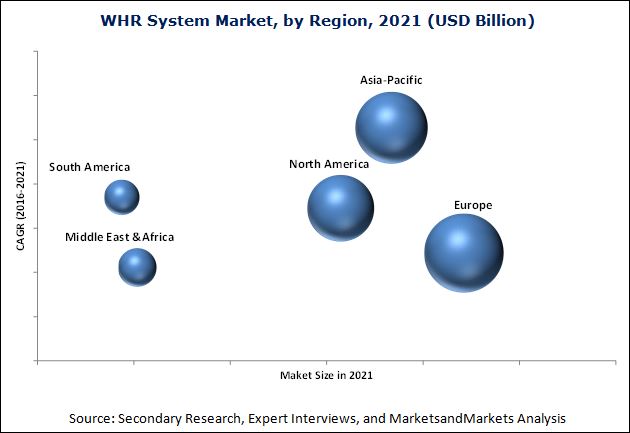The market size of waste heat recovery (WHR) system was USD 44.14 billion in 2015 and is projected to reach USD 65.87 billion by 2021, at a CAGR of 6.90% between 2016 and 2021. The WHR system market is segmented on the basis of application, end-use industry, and region.
The steam & electricity generation application segment accounted for the highest share of the overall WHR system market in 2015. The growing construction sector in various developing countries such as China and India is the major driver for the WHR system in the region, which is backed by high demand for WHRS in the cement industry. The steam & electricity generation application is projected to register the highest CAGR from 2016 to 2021.
The demand for WHRS in the cement industry is projected to register the highest CAGR during the forecast period. The growing construction industry in Asia-Pacific and some parts of Africa and South America will drive the demand for WHRS in this industry. Growth in the construction sector of developing countries, such as China, India, and Indonesia, for social and education, healthcare, retail, and residential construction will also drive the need for WHRS in the cement industry.
Asia-Pacific is expected to be the fastest-growing WHR system market, followed by South America. Growing end-use industries in Asia-Pacific, accompanied by development of new technologies and products, is projected to make it an ideal destination for the WHR system market.
Some of the major players operating in the WHR system market are ABB Ltd. (Switzerland), Amec Foster Wheeler (U.K.), Ormat Technologies Inc. (U.S.), General Electric Co. (U.S.), Mitsubishi Heavy Industries Ltd. (Japan), Echogen Power Systems Inc. (U.S.), Econotherm Ltd. (U.K.), Thermax Limited (India), Siemens AG (Germany), and Cool Energy Inc. (Colorado). Most of the companies have adopted supply contract and agreements as their development strategies to sustain in the global market.
This research study also includes a detailed segmentation of the WHR system market based on application, end-use industry, and region. Apart from the market segmentation, this report also adopts the Porter’s Five Forces analysis for an in-depth analysis of the market dynamics such as drivers, restraints, and opportunities.



